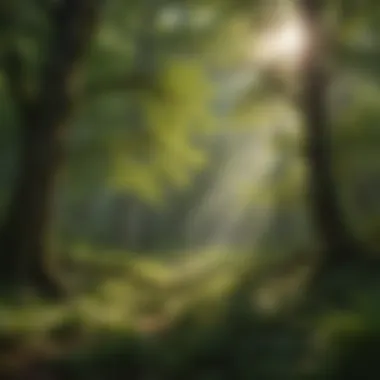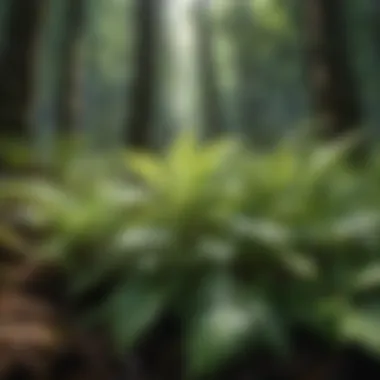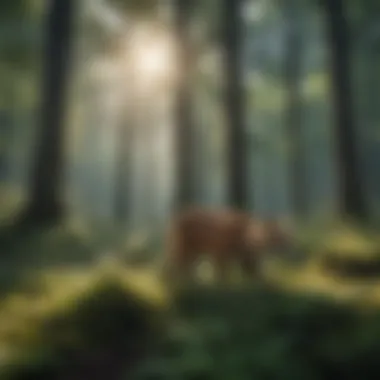Effects of Sun's Ultraviolet Radiation on Forest Ecosystems


Intro
As the sun casts its radiant beams upon the Earth, its light does not merely illuminate our surroundings; it plays a pivotal role in the health and balance of forest ecosystems. Ultraviolet (UV) radiation, a component of sunlight, is a double-edged sword. It can offer advantages, like stimulating growth and photosynthesis, yet it can also pose severe threats to forests, impacting both the flora and fauna that call these ecosystems home.
Understanding how UV radiation interacts with various components of forest ecosystems is crucial. The implications are far-reaching, affecting everything from plant health to animal behavior, and even the overall biodiversity within these areas. In the course of this article, we will explore these dynamics, shedding light on types of UV rays, their biological consequences, and examine the underlying principles of sustainable forestry to protect our forests from its harmful effects.
Through careful analysis and discussion, we aim to foster a richer appreciation for the delicate interactions within forest ecosystems and highlight the necessity of maintaining their vitality in the face of environmental challenges.
Prologue to Ultraviolet Radiation
Ultraviolet radiation, often referred to simply as UV radiation, is a key factor influencing the health and dynamics of forest ecosystems. Its role in these environments cannot be overstated, as it affects everything from plant growth to animal behavior. Understanding UV radiation is critical for forestry professionals and academics, given the ongoing climate changes and alterations in ecosystems. This section serves to illuminate what UV radiation is and where it comes from, establishing a foundation for the subsequent discussions regarding its effects on both flora and fauna.
Defining Ultraviolet Radiation
Ultraviolet radiation is a segment of the electromagnetic spectrum that sits between visible light and X-rays. It is typically classified into three types: UVA, UVB, and UVC. The distinction between these types is based on wavelength, with UVA having the longest wavelengths and UVC the shortest. These rays can be both beneficial and harmful. While some levels of UV exposure play a vital role in plant growth – such as promoting the synthesis of essential compounds – excessive exposure can lead to detrimental effects on both plant and animal life.
A simple definition might say that UV radiation is sunlight’s less visible arm, influencing various biological processes.
Sources of Ultraviolet Radiation
The sun is by far the primary source of ultraviolet radiation. Although the Earth’s atmosphere absorbs a significant portion of UVC rays, about 95% of the UVA and UVB rays reach the surface. Other sources include:
- Artificial Lighting: Certain types of fluorescent and halogen lights also emit UV rays.
- Tanning Beds: These devices are engineered to emit UV radiation for cosmetic tanning but can cause serious health risks.
- Industrial Processes: Some manufacturing processes may generate UV radiation as a byproduct.
It's important for forestry professionals to understand these sources, as they can help assess the overall UV exposure levels in different forest environments. > A comprehensive grasp of UV origins allows for better management of forest ecosystems amid changing climate patterns.
As we progress through this article, we will deep dive into the specific effects of UV radiation on forest flora, fauna, and overall ecosystem dynamics.
Types of Ultraviolet Radiation
Understanding the types of ultraviolet radiation is crucial in grasping how these rays interact with forest ecosystems. Each category of UV radiation—UVA, UVB, and UVC—plays a distinct role in influencing both the flora and fauna within forests. These types differ primarily in their wavelengths, with implications for biological activity, ecosystem functionality, and responses to environmental changes.
UVA: The Long-Wavelength Radiation
UVA radiation is characterized by its long wavelengths, ranging from 320 to 400 nanometers. This type of radiation penetrates deeply into the forest canopy, reaching the lower layers where various plants and animals reside. Its importance in forest ecosystems cannot be overstated.
- Photosynthetic Action: Many plants utilize UVA light in conjunction with visible light for photosynthesis. Though not as effective as its shorter counterparts, it supports the growth and development of those sensitive species.
- Effect on Flora’s Defense Mechanisms: Exposure to UVA can trigger biochemical pathways in plants that enhance their defensive compounds. This is vital for protecting them against pests and diseases.
In a nutshell, while UVA might seem less harmful compared to UVB and UVC, its role in the ecosystem is deeply woven into the very fabric of plant adaptability and resilience.
UVB: The Medium-Wavelength Radiation
Then, we move to UVB radiation, which falls in the medium-wavelength range of 280 to 320 nanometers. This type of UV radiation is more potent compared to UVA, and it can induce significant biological effects.
- Photosynthesis and Growth Regulation: UVB is known to enhance the production of specific proteins in plants that are crucial for photosynthesis. Moreover, it can regulate plant growth patterns, altering height and leaf orientation to optimize light capture.
- DNA Damage and Repair Mechanisms: One of the more concerning effects of UVB exposure is the potential for DNA damage in both plants and animals. Trees, for instance, may experience mutations which could affect seed viability and growth. Luckily, plants have developed intricate repair mechanisms over time, which allow them to cope with this stress.
UVB’s dual role—as both a promoter and stressor—makes it an essential player in forest dynamics.
UVC: The Short-Wavelength Radiation
Finally, there’s UVC radiation, which spans wavelengths from 100 to 280 nanometers. UVC is the most harmful of the three types, but its natural occurrence is limited due to absorption by the ozone layer.


- Impact on Microbial Communities: Studies show that if UVC reaches forest areas, it can significantly affect microbial life in the soil. These microbes play a vital role in nutrient cycling and overall soil health. Changes in their populations can have cascading effects on forest ecosystem health.
- Potential for Synthetic Sources: With advancements in technology, artificial UVC radiation sources are becoming more prevalent in various fields such as horticulture. This raises concerns about their effects on non-target species in natural settings.
In summary, while UVC rarely reaches the Earth's surface due to the protective ozone layer, any increase in synthetic UVC exposure could pose a serious threat.
Effects of UV Radiation on Forest Flora
The impact of ultraviolet (UV) radiation on forest flora is a vital element of this discourse, especially when considering the intricate relationships within forest ecosystems. Plants, being the backbone of these ecosystems, depend significantly on sunlight for photosynthesis, which in turn supports life at every level—animals, fungi, and bacteria alike. However, with the increasing intensity of UV radiation due to factors like ozone depletion, examining how this radiation affects plant health and productivity becomes imperative.
Impact on Photosynthesis
Photosynthesis is the process that allows plants to convert light energy into chemical energy. It's like a buffet of sunlight where plants feast to nourish themselves. UV radiation, particularly UVB, can let in a little too much sunlight, disrupting this delicate process. Research shows that higher concentrations of UV radiation can cause direct damage to the chloroplasts, where the magic of photosynthesis happens. The damage can decrease the efficiency of photosynthesis, reducing overall biomass and growth rates of trees and plants. This decline not only hampers the individual plants but can cascade through the entire ecosystem.
- Fast Fact: A study observed that young saplings exposed to elevated UVB levels exhibited up to a 30% reduction in photosynthetic efficiency compared to those shielded from UV radiation.
Alterations in Plant Morphology
When a plant is exposed to heightened levels of UV radiation, it might just decide to bulk up its defenses. This leads to physical changes known as morphological adaptations. Think of it as a plant donning armor to ward off potential threats. For instance, many species begin to develop thicker leaves or enhance their leaf angles to reduce UV exposure. Some may even forge additional trichomes (small hair-like structures) or change leaf coloration, often producing more pigments like anthocyanins, which act like little sunscreens.
- Surprising Shift: Studies have revealed some plants adapt to UV by altering their growth forms, becoming more compact with a denser branching pattern. This adaptation can significantly affect how they compete for light and resources.
Changes in Secondary Metabolite Production
Plants are not just passive beings; they are proactive creators of substances that help them cope with stress. One of the fascinating responses to increased UV radiation is the change in secondary metabolites. These compounds aren't directly involved in growth; instead, they serve various functions such as deterring herbivores or attracting pollinators. Increased UV radiation can trigger plants to synthesize more polyphenols, flavonoids, and other antioxidants. These compounds help mitigate UV damage and can also influence plant interactions with herbivores and other organisms in their environment.
"Secondary metabolites serve as the chemical arsenal that enables plants to thrive under UV stress, acting both for defense and for communication."
In summary, the effects of UV radiation on forest flora are multifaceted, affecting everything from photosynthesis to growth forms and chemical defenses. Understanding these impacts not only enhances our grasp of plant biology but also helps inform forest management strategies and conservation efforts aimed at maintaining healthy ecosystems.
Effects of UV Radiation on Forest Fauna
The effects of ultraviolet (UV) radiation on forest fauna hold great significance in understanding the overall health of forest ecosystems. Animals, much like plants, are not immune to the impacts of UV exposure. In fact, the radiation influences behaviors, reproduction, and health in many species. Thus, it becomes crucial not only to identify these effects but also to comprehend how they intertwine with other ecological elements. Moreover, the implications are far-reaching, affecting biodiversity and ecosystem dynamics.
UV Influence on Animal Behavior
Ultraviolet radiation can affect animal behavior in various intriguing ways. Many animals rely on specific visual cues for their survival, such as finding food or choosing mates. Certain species, like butterflies and bees, utilize UV patterns on flowers that are invisible to the naked eye. When UV radiation levels fluctuate, these unique visual signals can be altered. The result? A potential mismatch between pollinators and plants, possibly affecting reproduction rates of flora and, consequently, the food source of fauna.
Consider birds who engage in mate selection. In many species, feather coloration is partially determined by UV reflectance. Changes in UV patterns elicit different responses from potential mates and may adversely impact breeding behaviors, leading to a decline in population sizes over time. Therefore, it is evident that UV radiation plays a crucial role in the intricate dance of nature, influencing who eats who and who mates with whom.
Implications for Wildlife Health
The implications of UV exposure extend beyond behavior, significantly affecting wildlife health. Prolonged exposure to UV radiation can lead to a myriad of health issues among forest-dwelling fauna. One notable consequence is the increased susceptibility to skin cancer, particularly in species with less fur or feather coverage. Evidently, this poses a threat not only to individual animals but to entire populations. Furthermore, rising UV levels can compromise the immune system of certain species, making them more vulnerable to diseases.
In addition to direct health effects, there's an indirect risk posed to the food web. If UV radiation leads to declines in herbivore populations due to health deterioration, the predators depending on them for food must adapt to shifts in availability. Thus, it creates a ripple effect, highlighting the interconnectedness of the ecosystem.
"An ecosystem is like a well-tuned orchestra, where even the smallest change in one instrument can disrupt the entire harmony."
The Role of UV Radiation in Ecosystem Dynamics
In the intricate ballet of forest ecosystems, ultraviolet (UV) radiation plays a pivotal role, influencing various biological and ecological processes. The significance of UV radiation stretches beyond mere environmental concern; it is crucial for maintaining the balance within forest habitats. The way plants and animals adapt to and are affected by UV rays reveals a broader narrative about coexistence and survival in nature.
UV Radiation and Biodiversity


Biodiversity acts as the foundation for a healthy ecosystem. UV radiation shapes the very fabric of biodiversity through selective pressures and adaptations among species.
- Photosynthetic Organisms: The spectrum of UV radiation penetrates deeply into forest canopies, affecting growth patterns in plants. Species adapted to higher UV levels often generate protective compounds like flavonoids, which can provide them with a survival advantage. While not all plants respond positively, many undergo evolutionary adjustments that enhance resilience, thereby contributing to overall biodiversity.
- Animal Adaptations: Animals too are not mere spectators in this process. Various creatures, from insects to larger mammals, display changes in behavior and physiology. For instance, certain birds have developed UV-reflecting feathers that may play a role in mating displays, making them more attractive to potential partners. Such adaptations bolster reproductive success, allowing species to thrive despite the challenges UV radiation presents.
- Microbial Communities: The role of UV radiation extends to soil ecosystems, where microbial diversity is influenced. UV exposure can have selective effects on microbial strains, potentially enhancing or inhibiting the growth of specific species. This interplay ensures that nutrient cycling and decomposition processes remain robust and efficient, sustaining the forest ecosystem.
"The diversity seen in just a square meter of forest floor is a testament to nature's ingenuity in adapting to UV radiation, ensuring complex interactions continue to thrive."
Interaction with Other Environmental Factors
Understanding how UV radiation interacts with other environmental factors is key in grasping its true impact on forest dynamics. The effects of UV rays do not exist in isolation; they intertwine with several abiotic and biotic components of the ecosystem.
- Climate Change: Increased atmospheric ozone depletion results in higher levels of UV radiation reaching the Earth’s surface. This has cascading effects on forest health, with trees showing variations in growth patterns, leaf phenology, and stress responses. Particular focus on temperature and precipitation patterns alongside UV exposure becomes essential for understanding ecosystem responses.
- Soil Quality: Soil composition and quality also determine the extent to which UV radiation influences the forest biome. Healthy soils can moderate UV impacts. For example, organic matter can absorb some UV light, reducing its intensity on plants while supporting the nutrient needs of diverse organisms.
- Pollution: Airborne pollutants can either enhance or diminish UV radiation effects. Particulate matter can scatter UV rays, while some chemicals may contribute to the breakdown of ozone, intensifying UV exposure. This creates a complex web of interactions where understanding the direct and indirect effects becomes crucial for forest management.
To navigate these intricate relationships, monitoring programs that track both UV radiation levels and other environmental variables are vital. Forest ecosystem managers must recognize the multifaceted ways in which UV interacts with climate, soil, and human-induced changes.
In essence, unraveling the complexities of UV radiation's role in ecosystem dynamics unveils a rich tapestry of interdependencies that shape the resilience and adaptability of forest ecosystems. By understanding these impacts profoundly, we equip ourselves with the knowledge necessary for effective conservation and management practices.
Adaptations of Forest Organisms to UV Radiation
Understanding how forest organisms adapt to ultraviolet radiation is crucial for grasping the overall health of ecosystems. Over time, plants and animals have evolved various mechanisms that allow them to cope with UV exposure. This section delves into the evolutive strategies in flora and behavioral adaptations in fauna, showcasing the intricate dance of survival in a shifting environment.
Evolutive Strategies in Flora
Plants are resilient, often displaying remarkable evolutive strategies to manage the effects of UV radiation. For instance, many tree species produce UV-absorbing compounds known as flavonoids and phenolic acids, which act like a natural sunscreen. These compounds shield plant tissues from high energy radiation, reducing cellular damage.
The anatomy of leaves also changes in response to UV exposure. Thicker cuticles offer enhanced protection against UV rays and minimize water loss. In some cases, leaves might take on a darker green coloration. This alteration isn't just for aesthetics; darker pigments can absorb more light, helping plants to optimize photosynthesis while warding off harmful UV radiation.
Moreover, certain species have developed unique flowering patterns. For example, some wildflowers bloom only during specific times of the day or seasons when UV levels are lower. This strategy ensures reproductive success without risking exposure to detrimental UV levels that could harm the plant’s reproductive parts.
"Plants are masters of adaptation; they shape themselves in response to their environment, especially given the relentless forces of nature."
Lastly, the relationship between symbiotic fungi and plants plays an interesting part in these adaptations. Mycorrhizal fungi can help the host plant to enhance nutrient uptake, which in turn strengthens the plant's robustness to withstand UV stress.
Behavioral Adaptations in Fauna
On the other end of the spectrum, animals that inhabit forest ecosystems have developed various behavioral adaptations to mitigate the adverse effects of UV radiation. For instance, many creatures alter their activity patterns. Nocturnal species often remain active during the night when UV radiation is minimal, conserving their energy and ensuring their survival.
Certain birds and mammals instinctively seek shade during peak UV hours. By adapting their habitat interactions, they significantly reduce exposure to harmful rays. Some animals, like many reptiles, also use foliage or burrows as hiding spots. This form of camouflage not only protects them from UV radiation but also assists in avoiding predators.
In terms of skin adaptations, some mammals have evolved thicker fur or layered skin that offers an added barrier against harmful rays. These adaptations not only provide protection from UV exposure but can also play a critical role in thermoregulation, essential for maintaining body temperature. Likewise, bird feathers might have undergone changes in structure, contributing to better UV reflection and absorption away from their skin, ensuring they don't trace harmful rays while basking in the sun.
The interplay between UV radiation and forest organisms paints a complex picture of adaptation and survival. It underlines the creative ways biodiversity navigates environmental challenges, ultimately shaping healthier forest ecosystems.
Mitigation of UV Radiation Effects
Mitigation of UV radiation effects is crucial for preserving the intricate balance within forest ecosystems. The sun’s ultraviolet rays, while essential for life, can cause various detrimental impacts on both flora and fauna when they exceed certain thresholds. Therefore, understanding and implementing mitigation strategies can help in maintaining biodiversity and overall forest health.
The approaches to mitigating the impact of UV radiation can take on different forms, from enhancing species’ resilience to adopting practical management methodologies. By reducing the adverse effects of UV radiation, we can safeguard the vitality of forests and the myriad of organisms that depend on them.
Introducing Shade Tolerance in Species
Incorporating shade tolerance in various plant species serves as a frontline strategy to combat the effects of increased UV radiation. Shade-tolerant species can thrive under the canopy, where they receive less direct sunlight, thus limiting their exposure to harmful UV rays. This adaptation not only aids individual species but also contributes to the multilayered structure of a forest, providing shelter for diverse life forms.


Some examples of shade-tolerant species include Fagus grandifolia, commonly known as American beech, and Acer saccharum, which is the sugar maple. These species develop broader leaves that efficiently capture sunlight filtered through the canopy, allowing them to perform photosynthesis without the high energy demand that comes with direct UV exposure.
An effective way to introduce shade tolerance within a forest is through targeted planting alongside other beneficial species. This method can create microclimates that buffer against harsh UV radiation, allowing ecosystem resilience to flourish.
- Benefits of introducing shade tolerance:
- Increased Biodiversity: Supports a wider range of species, thus stabilizing the ecosystem.
- Reduced UV Stress: Minimizes UV exposure for understorey plants.
- Enhanced Soil Quality: Works toward better nutrient recycling.
Forest Management Practices
Forest management practices play a pivotal role in mitigating UV radiation effects as well. Properly managed forests can promote healthy growth patterns among trees while simultaneously shielding vulnerable ones from excessive UV exposure. This balance is especially necessary as climate change continues to disrupt established ecosystems.
Key forest management strategies include selective logging, maintaining forest canopy density, and employing buffer zones near water sources. For instance, selectively logging enables the growth of young, shade-tolerant species, increasing overall forest resilience.
Additionally, employing controlled burns can remove dense underbrush that might hinder younger trees from receiving the necessary light. This practice, when executed correctly, can mimic natural processes that manage ecosystems sustainably.
- Effective management practices:
- Canopy Maintenance: Protects younger trees from direct sunlight.
- Buffer Zones: Preserve moisture and humidity levels that can limit UV exposure risks.
- Regular Monitoring: Assess health indicators to understand the ongoing impacts of UV radiation.
By investing in these mitigation strategies and understanding their significance, stakeholders can ensure that the forest remains a sanctuary for countless organisms while navigating the challenges posed by ultraviolet radiation from the sun.
Research and Future Directions
The effects of ultraviolet (UV) radiation on forest ecosystems is a topic of increasing significance as we navigate the challenges posed by climate change and environmental degradation. Understanding how sunlight, particularly the ultraviolet spectrum, interacts with forest fauna and flora is essential for forest management and conservation strategies. Recent studies have underscored the need to stay ahead of the curve in this area, given that UV radiation can influence not just plant productivity but also the overall health of ecosystems. Examining current research as well as the potential for future technological advancements will provide critical insights.
Current Research on UV Effects
Researchers are digging deeper into the various ways UV radiation affects forest ecosystems. Current investigations range from understanding the physiological effects of UV on trees and plants to how it impacts the interactions between species within these ecosystems. For instance, certain studies have shown that exposure to UV radiation alters the pigment composition in leaves, which could potentially lead to changes in photosynthesis efficiency. So, if we take, let’s say, red maple, the way its leaves react to UV light can be a game changer in how effectively it captures sunlight.
Additionally, ongoing long-term studies monitor how these effects vary across different geographic areas and climate conditions. These research efforts aim to build a more comprehensive understanding of how UV radiation contributes to biodiversity loss and shifts in species distribution. Understanding these variables helps in managing forests by tailoring conservation strategies more carefully, taking into account the complex web of life affected by UV exposure.
Emerging Technologies and Findings
The landscape of research on UV radiation is continually evolving, harnessing new technologies to delve deeper into the effects of UV radiation on forest ecosystems. One area of focus is the use of remote sensing technologies to measure UV radiation exposure from above. These tools can provide data that is both spatially and temporally rich, enabling researchers to create more accurate models of how UV impact varies across different forest types.
Moreover, genetic studies are on the rise, providing insights into how certain species develop resistance to UV exposure over time. For example, scientists are now exploring specific genetic markers in plants that confer enhanced UV resistance, which could guide breeding programs aimed at improving the resilience of forests. This is not just an academic endeavor; it links directly to practical applications in forestry management and restoration efforts.
The End
Understanding the implications of ultraviolet radiation on forest ecosystems is crucial, not just for the scientific community, but also for policymakers and conservationists. The complex interactions between UV radiation and various species highlight the fragility of these ecosystems. While UV light is a natural and vital part of life on Earth, its excessive exposure poses numerous challenges to both flora and fauna, potentially altering growth patterns, metabolic processes, and even community dynamics.
Summarizing the Impacts
The impacts of ultraviolet radiation extend far beyond merely affecting photosynthesis. Here are some highlighted points:
- Photosynthesis Disruption: Plants, the backbone of any forest, suffer when UV exposure becomes deleterious. Their ability to capture sunlight efficiently could diminish, leading to reduced productivity.
- Morphological Changes: Increased UV levels can lead to changes in leaf structure, with plants developing thicker cuticles or altered pigmentation as protective measures. These adaptations, while beneficial in the short term, could affect overall growth and competitive dynamics among species.
- Effects on Wildlife: Animal behavior and health are also at stake. Changes in plant cover can impact animal habitats and food sources. Animals may adapt their behaviors, such as altering breeding patterns or foraging strategies, in response to the shifts in plant communities.
In short, the ramifications of UV radiation touch on every aspect of the forest ecosystem, influencing biodiversity and the resilience of these critical habitats.
Call to Action for Conservation
As the research unveils more insights on the interactions between UV light and forest ecosystems, it is essential for stakeholders at all levels to embrace conservation strategies. Here are steps that can be taken:
- Promote Shade Tolerance: Encourage the growth of shade-tolerant species in reforestation initiatives. This tactic helps in mitigating UV radiation's impacts.
- Support Sustainable Forestry Practices: Forest management techniques that prioritize biodiversity are essential. Implementing selective logging and creating buffer zones can play a significant role in maintaining ecosystem balance.
- Educational Outreach: Encourage communities to engage with these topics, promoting awareness on how UV radiation not only affects forests but also the health of our planet.
In light of the overwhelming evidence and changing conditions, it's imperative that we act decisively to mitigate the effects of ultraviolet radiation and protect the delicate balance of our forest ecosystems.



